| |
Picture Gallery (Click on picture for larger view) |
 |
 |
 |
| |
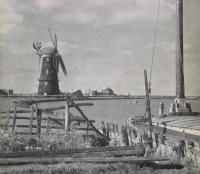 |
|
Early
view of mill
This view dates from the mid 20th century and shows the mill with
its sails and the cottages in the background.
(c1947 - Hallam
Ashley) |
|
 |
| |
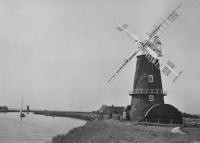 |
|
Berney
Arms mill in the 1950s
A good view of the mill at a time when holidays on the broads and
rivers were becoming popular. The curve of the river is clearly visible
at this point.
(c1950s - Ministry of Works) |
|
 |
| |
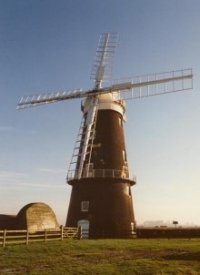 |
|
Glorious
Displaying its sails in all their glory, Berney Arms Mill stands tall
on a beautiful Spring morning. The scoop wheel can also clearly be
seen on its Eastward side.
(March 1989 - Andrew Barton) |
|
 |
| |
 |
|
Summer
boat traffic at Berney Arms
The heavy boating traffic moors up against the mill waterfront whilst
the mill tower turns its fantail towards the river. (Mid
1990s - Mark Healy) |
|
 |
| |
 |
|
Berney
Mill at sunset
Set against a glorious sunset the high mill at Berney Arms makes an
imposing sight.(Early 1990s - Mark Healy) |
|
 |
| |
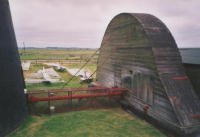 |
|
Scoop
wheel
Powered by the turning sails and used to drain the surrounding marshes,
the scoop wheel is driven by a horizontal shaft by means of an iron
pinion and internally geared ring. The wheel sits inside a closely
fitting brick culvert and when turning served to scoop the water from
the lower level of the marsh into the river.
(July
23rd 2000 - Andrew Barton) |
|
 |
| |
 |
|
Scoop
wheel close-up
A close-up view of the paddles inside the scoop wheel housing. The
driving shaft from the mill tower can be seen on the left. (August
15th 2004 - Andrew Barton) |
|
 |
| |
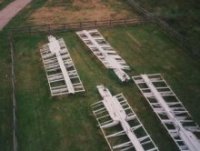 |
|
Sails
Laying forlornly to the North side of the mill tower the old sails
await replacement, intended for completion later in the year 2000.
(July 23rd 2000 - Andrew Barton) |
|
 |
| |
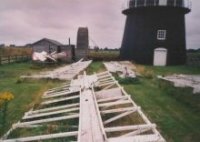 |
|
Mill
with abandoned sails
Mill tower and scoop wheel in the background with the abandoned sails
awaiting replacement. On the left near the shed the fantail assembly
can also be seen.
(July 23rd 2000 - Andrew Barton) |
|
 |
| |
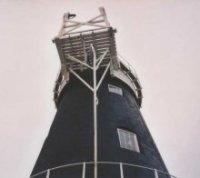 |
|
Sail-less
tower
View up to the top of the mill tower showing the cap with the staging
for the fantail, temporarily removed along with the main sails. The
fantail, or fly, is used to keep the main sails facing directly into
the wind to achieve maximum power. The vertical tailpole which serves
to guide the striking chain can also be seen. The striking chain controls
the opening and closing of the sail vanes by means of connecting irons
and cranks allowing the mill to be governed for speed.
(July
23rd 2000 - Andrew Barton) |
|
 |
| |
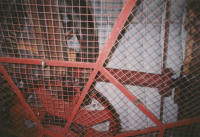 |
|
Cap
mechanism
Looking up into the cap the main windshaft can be seen running right
to left. This shaft is the one on which the sails rotate, conveying
their power via gears to the upright shaft which runs up the centre
of the tower. At the base of the mill other gears are used to turn
the drive through 90° in order to drive the scoop wheel.
(July
23rd 2000 - Andrew Barton) |
|
 |
| |
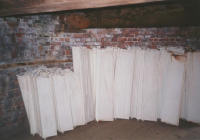 |
|
Vanes
Stacked up inside the mill tower the vanes await re-use on the new
sails. (July 23rd 2000 - Andrew Barton) |
|
 |
| |
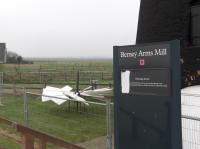 |
|
The fantail returns
After seven years as a shadow of its former self, it looks like things are starting to happen at last. The fantail has now arrived on site and awaits erection by millwright company R. Thompson & Son of Lincolnshire.
(April 12th 2007 - Andrew Barton) |
|
 |
| |
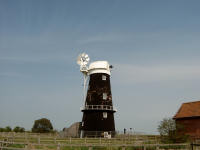 |
|
The fantail in position
The fantail has now been erected on the tower and the mill awaits the return of the stocks and sails.
(April 22nd 2007 - Dave Rogers) |
|
 |
| |
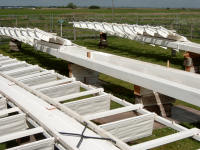 |
|
The main sails are back on site
At long last the main stocks and sails have reappeared on site in preparation for installation on the mill.
(May 13th 2007 - Dave Rogers) |
|
 |
| |
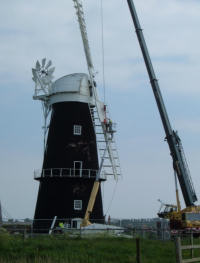 |
|
The first sails are in place!
It's been a long time coming but the first pair of main sails are hoisted into position with the help of a large crane. (May 23rd 2007 - Sheila & Paul Hutchinson) |
|
 |
| |
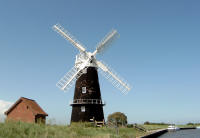 |
|
They're back!
After seven long years, the windmill at Berney Arms has at last taken on its rightful appearance as both pairs of sails are back in position. (June 2nd 2007 - Dave Rogers) |
|
 |
 |



